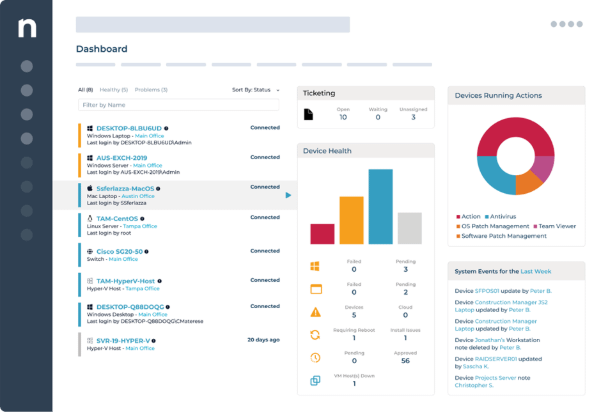Effortless Device Onboarding with NinjaOne for Modern IT Teams
Simplify the way you onboard devices with NinjaOne’s agile and unified platform.
Whether you’re setting up ten laptops or rolling out hundreds of mobile endpoints, NinjaOne streamlines every step of the device onboarding process.

NinjaOne helps IT teams get new devices up and running faster
Unified Platform for Device Deployment
Automated Configuration for Faster Setup
Policy-Driven Device Standardization
Real-Time Visibility During Onboarding
Secure, Role-Based Onboarding Workflows
NinjaOne delivers smart tools that simplify and strengthen onboarding
Multi-OS Enrollment and Policy Enforcement
Integrated Software Deployment Tools
Custom Scripting with Centralized Library
Real-Time Alerts and Compliance Checks
Pre-Built Templates for Fast Rollouts
NinjaOne supports modern onboarding flows for any organization
New Employee Laptop Deployment Made Easy
MSPs Standardizing Client Onboarding Across Environments
Managed Service Providers can simplify client device onboarding by applying consistent workflows across tenants. IT teams define unique onboarding flows per client, including scripts, software packages, and access controls. NinjaOne enables MSPs to manage onboarding across multiple organizations from a single pane of glass—improving efficiency, reducing errors, and meeting SLAs with ease.
Bulk Device Rollouts for Remote Offices
Streamline Every Device Launch with Confidence

Device Onboarding FAQs
What is device onboarding?
Device onboarding is the process of connecting a new device—such as a computer, server, or mobile device—to a network or management platform so it can be monitored, secured, and managed. This includes configuring the device with necessary settings, installing software or agents, applying security policies, and validating its identity. Effective device onboarding support helps streamline this process, ensuring consistency and reducing manual effort. Onboarding is often the first step in lifecycle management and is essential for ensuring devices comply with organizational IT policies from the moment they come online.
How to onboard devices?
Onboarding devices typically involves several key steps: preparing the device, enrolling it into a centralized management system (like in RMM or MDM platform), deploying required configurations or profiles, and verifying successful registration. This process can vary depending on the device type and operating system. For instance, IT teams may use enrollment URLs, QR codes, or provisioning scripts to speed up the process. Once enrolled, the device can receive remote updates, monitoring, and support.
How to automate onboarding process of devices?
Automating device onboarding involves using scripts, APIs, zero-touch provisioning, or integration with directory services (like Azure AD) to reduce manual setup time and minimize errors. For traditional endpoints, tools like RMM and MDM platforms allow IT teams to auto-deploy agents, push configurations, and apply policies based on device type or user role. Well-structured device onboarding flows ensure these steps happen in the correct order, increasing reliability and repeatability. In IoT environments, automation may involve the use of device templates, bulk provisioning tokens, and secure identity management protocols. Automation streamlines large-scale deployments, reduces administrative overhead, and enhances security consistency.
Related Resources
IT Client Onboarding Checklist for MSPs
Driving Business Efficiency with Endpoint Management
Automating New Device Setup with NinjaOne
